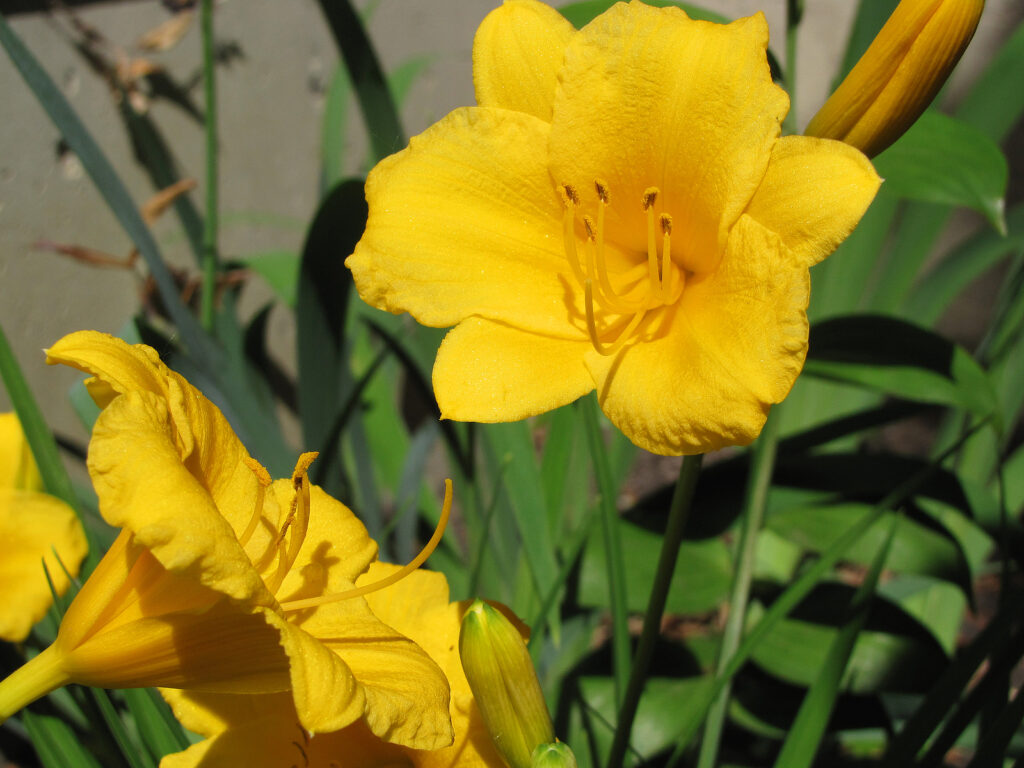Daylilies, Hemerocallis, bear large, trumpet blooms, each lasting a day. Flowers are often yellow or orange, but there are many color variations. The daylily is a perennial that has narrow, upright, and arching glossy green leaves.
There are about 15 species of evergreen, semi-evergreen, and herbaceous daylilies. From those species come more than 50,000 named cultivars. Many named varieties are registered with the American Hemerocallis Society. That said, only a few are offered by nurseries.
Daylily flowers come in a variety of forms. The flowers may be triangular, with triangular to rounded, flat or ruffled-margined tepals; double, with rounded or tapered, flat or ruffled-margined outer tepals; star-shaped with tapered or sometimes rounded, flat, or ruffled-margined tepals; or spider-shaped with mostly narrow, tapered tepals. Hot weather may cause some daylilies to bear flowers with extra petals and stamens.
Many daylilies are remontant, flowering repeatedly during the season. The flowers range in color from almost white through yellow and orange to dark purple and deepest red-black, Most flowers last for only a day; in nocturnal daylilies, the flower opens in the late afternoon and lasts throughout the night. The flowering of extended-blooming daylilies remains open for at least 16 hours.
Daylilies are also classified by bloom season. Select a mix of early-season bloomers, mid-season and late season bloomers to extend the bloom season. Reblooming daylilies produce a main flush of bloom that is followed by additional spikes later in the season.

Get to know daylily–Hemerocallis
- Plant type: Perennial
- Growing Zones and range: Zones 4-10
- Hardiness: Hardy to -20°F (-29VC). Most varieties are deciduous; some in southern regions are evergreen; generally daylilies are hardy in Zones 3 to 10.
- Height and width: Generally 12 to 48 inches (30-120cm); 6 to 48 inches (15-120cm) wide, depending on the variety
- Foliage: Arching, strap-shaped dark green leaves, usually 30 to 48 inches (76-120cm) long, but often 9 to 14 inches (23-35cm) long
- Flowers: Lily or chalice shaped blossoms from 3 to 8 inches acorss in standard hybrids; 1.5 to 3 inches across in miniature kinds.
- Flower colors: Every color but blue; flowers last one day
- Bloom time: Flowers last one day; they open every day in early summer, midsummer, or late summer depending on the variety
- Uses: Plant in mass; use in mixed borders; combine early, mid, and late-season varieties for a long season of blooms
- Common name: Hemerocallis spp.
- Botanical name: Daylily
- Family: Liliaceae
- Origin: China, Korea, and Japan

Where to plant daylily–Hemerocallis
- Plant daylilies in full sun. Daylilies will tolerate shade, but they will have fewer blooms.
- Grow daylilies in humus-rich, well-drained soil.
Daylily–Hemerocallis uses and companions
- Plant Hemerocallis in groups in beds and borders.
- Use Hemerocallis for erosion control on banks.
- Good garden companions for Hemerocallis include Anchusa, Centranthus rubber, Chelone, Chrysanthemum superbum, Delphinium, Dictamus albus, Gaillardia, Geranium, Gypsophila paniculata, Kniphofia, Lupinus, Paeonia.
When to plant daylily–Hemerocallis
- Set out established daylilies in spring or fall.
Planting and spacing daylily–Hemerocallis
- Space daylilies 12 to 48 inches (30-114cm) apart or more depending on the cultivar. Group 6 daylilies or more together for best effect.
- Plant tubers twice as deep as the width of the tuber.

How to water and feed daylily–Hemerocallis
- Keep the soil evenly moist for daylilies. Daylilies like moderate to ample water. Mature plants can tolerate drought.
- Fertilize daylilies with an all-purpose fertilizer every 6 weeks or work in a 9-month, slow-release fertilizer early in the season.
Daylily care
- Trim away spent flowers to encourage more blooms.
- Divide daylilies every 3 to 4 years as needed.
- Mulch daylilies in late autumn or spring.
- Deer will eat daylily buds.

Hemerocallis – daylily pests and diseases
- Daylilies are susceptible to rust.
- Daylilies can be attacked by gall midge, aphids, spider mites, and thrips.
- Slugs and snails may damage young leaves.
- Crown rot is usually a problem in high humidity and temperatures greater than 90F (32C).
- In areas where there is alternating winter freezes and thaws, bacterial leaf and stem rot may be a problem.
Hemerocallis – daylily propagation
- Divide hardy daylilies in spring or autumn.
- Divide all evergreen daylilies in spring.
- Hemeroallis seeds germinate in two to six weeks at 60° to 70°F (16°-21°C).
- Sow seed in containers in a cold frame in autumn or spring; seed from hybrids and cultivars do come true.

Hemerocallis – daylily varieties to grow
There are thousands of daylily varieties and cultivars. Here are well-known species and hybrids:
- Hemerocallis altissima: Grows to 5 feet tall’ bears fragrant yellow flowers in late summer.
- H. citrina, citron daylily: Heavy-blooming species can grow to 4 feet tall; produces fragrant pale lemon yellow trumpet blooms in summer.
- H. fulva, tawny daylily: Grows to 3 feet tall; semi-evergreen leaves and rusty-orange flowers; cultivar ‘Flore Pleno’ bears double flowers.
- H. hybrids: Hybrids are far more common than species daylilies and come in many colors, shapes, and sizes. Colors include peach, apricot, yellow-orange, maroon, orange-red, buffy orange, pinkish-lavender plum, pale yellow, or pink blooms that are nearly white. Best know varieties include ‘Stella de Oro’, ‘Black-Eyed Stella’, and ‘Happy Returns’.
- H. lilio-asphodelus (H. flava), lemon daylily: Grows to 3 feet high and bears fragrant yellow flowers in late spring,















